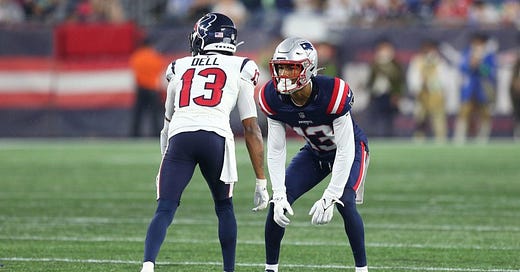Does the Preseason Matter? Wide Receiver Edition
Highlight clips are fun to watch, but not the best indicator of what rookies will do in the regular season
The preseason is into full swing with a full slate of matchups last week, and another couple on the horizon. The preseason has lost some importance over the last few years, with the 2020 season going off without a hitch despite no preseason, the shift from four to three games beginning in 2021, and a growing number of teams moving away from playing key starters at all. Still, we should see a lot from younger, unestablished players over in August, the players with the most uncertainty in their forward-looking projections.
Before we make too much from what we see this preseason, we need to look back at the past to see if there has been any signal in what we see in the preseason translating to the contests that count during the regular and postseason. This analysis is going to focus on wide receivers, specifically rookies. After a year in the NFL, you’re not likely to learn a ton from preseason play over what you saw (or didn’t see) in their rookie years. Previously, I looked at the significance of preseason play for early career quarterbacks, and found some insights to apply to the 2023 class. Then I dug into running back preseason correlations with rushing attempts over expectation in the regular season, and, again, found the most predictive stats.
For preseason data, I pulled numbers from PFF, including traditional volume (yards, targets) and efficiency stats (yards and targets per route run). I’m going to compare wide receivers’ preseason performances using those stats to their rookie-year rushing attempts over expectation, based on their draft position. What we’re primary interested in, especially in the fantasy football realm, is who will see volume during the season, so that’s what I’m focused on.
Spoiler alert: there are some strong correlation between certain preseason stats and volume over expectation in the regular season, but also a few types of measures that can fool observers into thinking a superficially strong preseason will translate.
VISUALIZING THE PRESEASON METRICS
In the plots below, I contrast different preseason efficiency metrics (2013-2022) on the X axis with rookie-year yards over expectation on the Y axis. First, I’ll show exactly how strong the relationship between draft position and rookie-year targets is, and why it’s the basis for calculating the above/below expectation numbers. The sample includes rookies with a minimum of 10 rookie-year routes run, contrasting wide receivers to tight ends and running backs. I gave UDFA’s a draft position of 300.
How far each rookie receiver falls above or below the trend-line above is the figure I’m using for over/under expectation. I figure it’s a lot more valuable to look at this number than draft agnostic attempts.
I couldn’t find much with preseason usage to predict production in the regular season for tight ends and running backs, so the rest of the plots will only include wide receivers. It’s good for rookies to be productive in the preseason, but straight yards per game isn’t the best predictor of regular season outperformance. The highlighted receivers are either top-10 in regular season yards over expectation or top-10 in the stat from the X axis.
Keep reading with a 7-day free trial
Subscribe to Unexpected Points to keep reading this post and get 7 days of free access to the full post archives.






